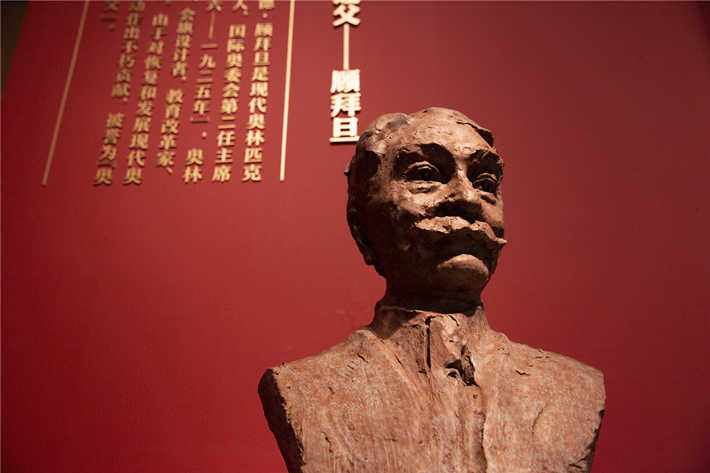Olympic Art

“Arts and letters harmoniously combined with sport assured the greatness of the Olympics… because athletics education exerts at least the same action on the moral as over the physical,” said Pierre de Coubertin, the founder of the modern Olympic Games, in 1889, “and if one side builds muscle, it also forms the character and will.”
An Olympic-themed art exhibition called “Greeting the Winter Olympics, Beauty in Chasing Dreams” opened at the National Art Museum of China (NAMOC) on January 7, 2022. The exhibition featured more than 160 artworks including traditional Chinese paintings, oil paintings, and sculptures. Across two chapters, “Dream and Striving” and “Advocating and Competition,” the exhibition vividly shared the story of China’s sports development with the world and carried forward the Olympic spirit.

Coubertin by Wu Weishan, sculpture,76×60×40cm,2017, collected in the International Olympic Committee headquarters. by Qin Bin/China Pictorial
The Chinese nation has a long tradition of engaging in competitive sports. This exhibition featured many artworks themed on traditional Chinese sports. An outstanding example is the 1963 Chinese painting Playing Polo by noted artist Huang Zhou (1925-1997). It vividly portrays the dynamic competition scene of polo riders playing the sport on prancing horses. Polo was a popular sport among the royals and nobles in the Tang (618-907) and Song (960-1279) dynasties. More than 1,000 years later, the sport finally emerged in countries including Argentina, Britain, India, and the United States. Polo was played at the Olympic Games in 1908, 1920, 1924, and 1936.
In 1932, China attended the 10th Olympic Games in Los Angeles, its first appearance, but sprinter Liu Changchun was the country’s lone athlete. After nearly a century of development of national competitive sports, Chinese athletes have won medals and shone brightly on the Olympic arena, presenting the world an image of Chinese people constantly striving and forging ahead.

Playing Polo by Huang Zhou, traditional Chinese painting, 137×162.1cm,1963, collected in the National Art Museum of China (NAMOC). courtesy of NAMOC
Inspired by the touching scenes of Chinese athletes competing at the Olympic Games, Chinese artists seek to capture the dynamic power of the Olympics flavored by their unique understanding of the Olympic spirit. For example, the Chinese painting Before the Final Battle depicts the scene of players of the Chinese women’s volleyball team joining hands in a circle to encourage each other before the final, highlighting their unity and determination to win. The sculpture Challenge depicts a wheelchair athlete throwing a discus, impressing onlookers with the sportsmanship of perseverance.
The organizer of the exhibition also commissioned three contemporary artists, Li Yang, Shang Ke, and Huang Hua, to paint respective portraits of three Olympic winners—Wang Liping, women’s 20-kilometer race walking champion at the 27th Olympic Games in Sydney, Gao Ling, badminton mixed doubles champion both at the 2000 Sydney Olympics and the 2004 Athens Olympics, and Zhang Xiangxiang, men’s 62-kilogram weightlifting champion at the 2008 Beijing Olympics. The three Chinese paintings depict the valiant and heroic demeanor of Chinese athletes, enriching the Olympic spirit with Chinese style.

A series of black and white portrait photographs featuring Chinese Olympic champions by renowned Chinese photographer Pang Xiaowei. by Qin Bin/China Pictorial
Folk artworks are another highlight at the exhibition. A variety of folk sports with Chinese characteristics such as shuttlecock hacky sack, dragon boat racing, dragon lantern dancing, horse racing, and ice skating were displayed through artistic forms including traditional Chinese painting, sculpture, paper-cutting, and New Year painting. They enabled visitors to get a taste of the diversity of Chinese folk sports and Chinese people’s enthusiasm for sports.
“The practice of using art to portray sportsmanship and the Olympic spirit dates back to a long time ago,” noted Wu Weishan, director of NAMOC. “Olympic-themed artworks by ancient Greek artists have survived to this day. Chinese artists have also inherited this tradition with their own artistic expression. The exhibition was scheduled ideally to coincide with Beijing’s final preparations to host the Winter Olympic Games.”